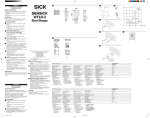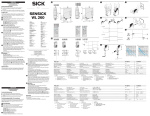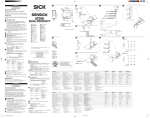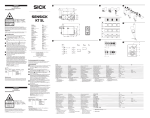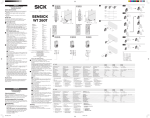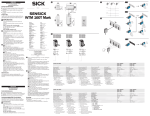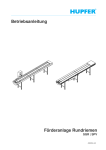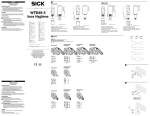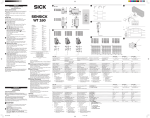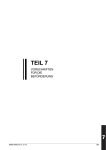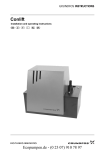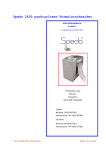Download A B 4 3 2 1
Transcript
A ENGLISH Photoelectric Proximity Switch with infrared light Operating Instructions Safety Specifications ‡ Read the operating instructions before starting operation. ‡ Connection, assembly, and settings only by competent technicians. ‡ Protect the device against moisture and soiling when operating. ‡ No safety component in accordance with EU machine guidelines. 8 008 964.1202 GO KE Proper Use 2 3 4 Maintenance WTR2-P511 S01 WTR2-P511 S03 WTR2-P521 S04 FR WTR (n-1) We reserve the right to make changes without prior notification Änderungen vorbehalten Angegebene Produkteigenschaften und technische Daten stellen keine Garantieerklärung dar Sous réserve de modifications Reservam-se alterações Ret til ændringer forbeholdes Con riserva di modifiche Wijzigingen voorbehouden Reservado el derecho a introducir modificaciones 2 DEUTSCH ‡ Vor der Inbetriebnahme die Betriebsanleitung lesen. ‡ Anschluss, Montage und Einstellung nur durch Fachpersonal. ‡ Gerät bei Inbetriebnahme vor Feuchte und Verunreinigung schützen. ‡ Kein Sicherheitsbauteil gemäß EU-Maschinenrichtlinie. 4 WTR zwischen den Rollen an geeignete Halter unter Förderniveau anschrauben (z.B. SICK-Haltewinkel). Dabei Tastweite TW (A), Förderrichtung, Abstrahlwinkel (5o), Abstand zum Fördergut (B)/Blindbereich beachten. Nur WTR 2-P 521/-N 551/-P 521 S04/-N 551 S05: D: dunkelschaltend, bei Lichtunterbrechung (Objekt nicht vorhanden) Ausgang (-P 521, -P 521 S04: QP, -N 551, – – -N 551 S05, -N 551 S06: QN, -P 551 S08: QP) aktiv; Nur WTR 2-P 511/-N 551/-P 511 S03/-P 511 S01/ -N 551 S05: L: hellschaltend, bei Lichtempfang (Objekt vorhanden) Ausgang (-P 511, -P 511 S01, -P 511 S03, -P 551 S08: QP, N 551 S05, -N 551: QN) aktiv. Einsatzbedingungen wie Tastweite, Objektgröße und Remissionsvermögen des Tastgutes sowie des Hintergrundes überprüfen und mit der Kennlinie im Diagramm vergleichen. (x=Tastweite, y=Übergangsbereich zwischen eingestellter Tastweite und sicherer Hintergrundausblendung (z) in % der Tastweite, Ro=Remission Objekt, Rh=Remission Hintergrund). Remission: 6%=schwarz, 18%=grau, 90%=weiß (bezogen auf Standardweiß nach DIN 5033). Justage Lichtempfang: Tastweite auf Max. stellen. Objekt positionieren. Lichtfleck auf Objekt ausrichten. Empfangsanzeige muss leuchten. Leuchtet sie nicht, WTR neu justieren, reinigen bzw. Einsatzbedingungen überprüfen. Einstellung Tastweite: Objekt entfernen, die Empfangsanzeige muss erlöschen. Leuchtet sie weiterhin, Drehknopf in Richtung Min. drehen, bis sie erlischt. Drehknopf auf Min. stellen. Objekt positionieren. Drehknopf in Richtung Max. drehen, bis die Empfangsanzeige aufleuchtet. Nur WTR 2-P621/-P621 S02: 1,5 m lange Leitung zum Anschluss eines separat in der Förderanlage montierten Ventils (Schaltstrom 600 mA). Die integrier te Logik erlaubt einen kontrollierten Stauvorgang an definierten Stauplätzen. Einzeleinlauf: Fördergut durchläuft den gesamten Einlaufbereich und wird erst am WTR (n) gestoppt. Sind zwei benachbarte Stauplätze belegt, dann wird das Fördergut gestoppt: Lückenbildung zwischen den Fördergütern. Bestimmungsgemäße Verwendung Wartung Der WTR ist ein optoelektronischer Sensor mit Logik und Ventilanschlussmöglichkeit oder ohne Logik/Ventilanschlussmöglichkeit, der zum berührungslosen Erfassen von Gegenständen auf Förderrollen und zur Steuerung der Stauplätze eingesetzt wird. SICK-Lichttaster sind wartungsfrei. Wir empfehlen, in regelmäßigen Abständen - die optischen Grenzflächen zu reinigen, - Verschraubungen und Steckverbindungen zu überprüfen. Inbetriebnahme 1 Leitungsdose spannungsfrei aufstecken und festschrauben. Für Anschluss in B gilt: brn=braun, blu=blau, blk=schwarz, wht=weiß; FR = Förderrichtung. Nur WTR 2-P621/WTR 2-P621 S02: WTR an Betriebsspannung legen (s. Typenaufdruck). Stromversorgung für weitere WTR: Leitungsdose des ersten Gerätes mit dem Gerätestecker des jeweiligen nächsten WTR verbinden. Die Leitungsdose des WTR (n) bleibt unverbunden. 2 * 3 Sicherheitshinweise 3 WTR 2-P621 S02 B SICK photoelectric switches do not require any maintenance. We recommend that you clean the optical interfaces and check the screw connections and plug-in connections at regular intervals. Reflexions-Lichttaster mit unsichtbarem Infrarotlicht Betriebsanleitung 1 WTR 2-P621 521/621 Starting Operation Connect and secure cable receptacle tension-free. The following apply for connection in B: brn=brown, blu=blue, blk=black, wht=white; FR = conveyor direction. WTR 2-P621/WTR 2-P621 S02 onl y: only: Connect WTR to operating voltage (see type label). Power supply for additional WTR: Connect the cable receptacle of the first device with the equipment plug of the respective next WTR. The cable receptacle of the last WTR (n) is not connected to anything. Mount the WTR with the mounting holes between the rollers at the suitable bracket below the conveyor level (e.g., SICK mounting bracket). Pay attention to the scanning distance (A), conveyor direction, angle of dispersion (5o) and the distance to conveyed products (B)/blind area. WTR 2-P 521/-N 551/-P 521 S04/-N 551 S05 onl y: only: D: dark-switching, if light interrupted (object not present), output (-P 521, – P, -N 551, -N 551 S05, – -P 521 S04: Q -N 551 S06: QN, -P 551 S08: QP) active; WTR 2-P 511/-N 551/-P 511 S03/-P 511 S01/ -N 551 S05 onl y: only: L: light-switching, if light received (object present), output (-P 511, -P 511 S01, -P 511 S03, -P 551 S08: QP, -N 551 S05, -N 551: QN) active. Check application conditions such as scanning distance, size and reflectance of object to be detected as well as of background, and compare with characteristic in diagram. (x=scanning distance, y=transition range between set scanning distance and reliable background suppression (z) in % of scanning distance, Ro=reflectance of object, Rh=reflectance of background). Reflectance: 6%=black, 18%=gray, 90%=white (based on standard white to DIN 5033). Adjustment of light reception: Set scanning distance to max. Position object. Position light spot on object. Signal strength indicator should light up. If it does not light up, readjust and/or clean WTR and/or check application conditions. Setting scanning distance: Remove object, signal strength indicator should go out. If it does not go out, turn switch towards min. until it goes out. Set switch to min. Position object. Turn switch towards max. until signal strength indicator lights up. WTR 2-P621/-P621 S02 onl y: only: 1.5 m long cable for connecting a valve mounted separately in the system (switching current 600 mA). The integrated logical device enables a controlled backup procedure at defined backup spots. Single feed: Conveyed product runs through the complete feeder area and is only stopped at WTR (n). If two neighboring backup spots are occupied, the conveyed product is stopped: A gap is created between the conveyed products. 2-P521 2-P511 2-P511 S07 2-P551 S08 2-N551 2-N551 S05 2-N551 S06 WTR 2 The WTR is an opto-electronic sensor with a logic device and a valve connection option or without a logic device and a valve connection option. It is used for contactless detection of objects on conveyor belts and for controlling backup spots (WTR 2-P621, WTR 2-P621 S02). 1 WTR WTR WTR WTR WTR WTR WTR Alarm WTR (1) 4 FRANÇAIS Détecteur réflex avec rayons infrarouge Instructions de Service Conseils de sécurité ‡ Lire les Instructions de Service avant la mise en marche. ‡ Installation, raccordement et réglage ne doivent être effectués que par du personnel qualifié. ‡ Lors de la mise en service, protéger l’appareil de l’humidité et des saletés. ‡ N’est pas un composant de sécurité au sens de la directive européenne concernant les machines. Utilisation correcte Le WTR est un capteur optoélectronique à logique et possibilité de raccorder une vanne ou bien sans logique ni possibilité de raccorder une vanne, et s’utilise pour la détection sans contact des objets défilant sur des convoyeurs à rouleaux par gravité et pour le pilotage des aires d’accumulation (WTR 2-P621, WTR 2-P621 S02). 2 Mise en service 1 2 3 4 Enficher la boîte à conducteurs sans aucune tension et la visser. Pour le raccordement dans B on a: brn=brun, blu=bleu, blk=noir, wht=blanc; FR = direction de convoyage. WTR 2-P621/WTR 2-P621 S02 uniquement: Appliquer la tension de service au capteur WTR (voir inscription indiquant le modèle). Alimentation électrique d’autres capteurs WTR: Raccorder la boîte à câbles du premier appareil à la fiche d’entrée du capteur suivant respectif. La boîte à câbles du nième WTR (n) reste non connectée. Monter le capteur WTR au moyen de ses trous de fixation sur des supports appropriés (par ex. équerre de fixation SICK) entre les rouleaux, sous le niveau de convoyage. Ce faisant, tenir compte de la distance de détection TW (A), direction de convoyage, angle de rayonnement (5o), distance à l’objet convoyé (B) ou champ sans visibilité. WTR 2-P 521/-N 551/-P 521 S04/-N 551 S05 uniquement: D: commutation sombre, la sortie – (-P 521, -P 521 S04: QP,–-N 551, -N 551 S05, -N 551 S06:QN, -P 551 S08: QP) est active lorsque le trajet lumineux est interrompu (pas d’objet présent); WTR 2-P 511/-N 551/-P 511 S03/-P 511 S01/ -N 551 S05 uniquement: L: commutation claire, la sor tie (-P 511, -P 511 S01, -P 511 S03, -P 551 S08: QP, -N 551 S05, -N 551: QN) est active à la réception de lumière (objet présent). Vérifier les conditions d’utilisation telles que distance de détection, taille de l’objet, facteur de luminance du matériel à détecter et de l’arrière-plan, et les comparer à la courbe caractéristique du diagramme. (x=distance de détection, y=plage de transition entre la distance de détection ajustée et une élimination certaine de l’arrière-plan (z) en % de la distance de détection, Ro=luminance objet, Rh=luminance arrière-plan). Luminance: 6%=noir, 18%=gris, 90%=blanc (par rapport au blanc étalon selon DIN 5033). Ajustement Réception de la lumière: Régler la distance de détection sur Maxi. Positionner l’objet. Pointer la tache lumineuse vers l’objet. Le témoin de réception doit rester allumé en permanence. S’il n’est pas allumé, nettoyer ou ajuster à nouveau le détecteur WTR, ou vérifier les conditions d’utilisation. Réglage Distance de détection: Enlever l’objet, le témoin de réception doit s’éteindre. Si le témoin reste allumé, tourner le bouton rotatif en direction Mini jusqu’à ce qu’il s’éteigne. Mettre le bouton rotatif en position Mini. Positionner l’objet. Tourner le bouton rotatif en direction Maxi jusqu’à ce que le témoin de réception s’allume. WTR 2-P621/-P621 S02 uniquement: Câble de 1,5 m de long pour le raccordement d’une vanne montée séparément dans l’installation (Courant de commutation 600 mA). La logique intégrée permet une accumulation contrôlée sur des aires d’accumulation définies. Entrée individuelle: le matériel convoyé traverse toute la zone d’entrée et est stoppé seulement au détecteur WTR (n). Si deux aires d’accumulation voisines sont occupées, matériel convoyé est stoppé: formation d’une lacune entre les objets convoyés. Maintenance 3 4 Manutenção Os sensores de luz SICK não requerem manutenção. Recomendamos que se faça, em intervalos regulares, - a limpeza das superfícies óticas, - e um controle às conexões roscadas e uniões de conetores. 4 SICK-fotoceller kræver ingen vedligeholdelse. Vi anbefaler, at - de optiske grænseflader rengøres - forskruninger og stikforbindelser kontrolleres med regelmæssige mellemrum. Instruções de segurança ‡ Antes do comissionamento dev ler as instruções de operação. ‡ Conexões, montagem e ajuste devem ser executados exclusivamente por pessoal devidamente qualificado. ‡ Guardar o aparelho ao abrigo de umidade e sujidade. ‡ Não se trata de elemento de segurança segundo a Diretiva Máquinas da União Europêa. 2 Utilização devida O WTR é um sensor optoelectrónico com parte lógica e possibilidade de conexão de válvula ou sem parte lógica/sem possibilidade de conexão de válvula, utilizado para detectar, sem contacto, objectos sensores em rolos de transpor te e para controlo de pontos de acumulação (WTR 2-P621, WTR 2-P621 S02). Comissionamento Enfiar a caixa de cabos sem torções e aparafusá-la. Para a ligação elétrica em B é: brn=marron, blu=azul, blk=preto, wht=branco; FR = o sentido de transporte. Só WTR 2-P621/WTR 2-P621 S02: Colocar o sensor na tensao de serviço (ver letreiro de tipo). Alimentação de corrente para outros WTR. 3 Gebruik volgens bestemming De WTR is een opto-elektronische sensor met logica en een ventielaansluitmogelijkheid of zonder logica/ventielaansluitmogelijkheid die voor het contactloos registreren van een object op transpor trollen en voor het sturen van stuwplaatsen (WTR 2-P621, WTR 2-P621 S02) wordt toegepast. Avvertimenti di sicurezza ‡ Leggere prima della messa in esercizio. ‡ Allacciamento, montaggio e regolazione solo da par te di personale qualificato. ‡ Durante la messa in esercizio proteggere da umidità e sporcizia. ‡ Non componente di sicurezza secondo la Direttiva macchine EN. 2 Impiego conforme allo scopo Il WTR è un sensore optoelettronico dotato di logica elettronica e collegamento per valvola oppure senza logica elettronica e collegamento per valvola che viene usato per il rilevamento senza contatto di oggetti su nastri di convogliamento e per il comando di aree di magazzinaggio (WTR 2-P621, WTR 2-P621 S02). Messa in esercizio 1 Beregnet anvendelse PORTUGUÊS ‡ Lees voor de ingebruikneming de gebruiksaanwijzing. ‡ Aansluiting, montage en instelling alleen door vakbekwaam personeel laten uitvoeren. ‡ Apparaat voor ingebruikneming tegen vocht en verontreiniging beschermen. ‡ Geen veiligheidscomponent conform EU-machinerichtlijn. ITALIANO ‡ Driftsvejledningen skal gennemlæses før idrifttagning. ‡ Tilslutning, montage og indstilling må kun foretages af fagligt personale. ‡ Apparatet skal beskyttes mod fugtighed og snavs ved idrifttagningen. ‡ Ingen sikkerhedskomponent iht. EU-maskindirektiv. Foto-célula de reflexão com luz infra-vermelha Instruções de operação Veiligheidsvoorschriften Sensore luminoso a riflessione con luce infrarossa Instruzioni per l'uso Sikkerhedsforskrifter Ledningsdåse monteres spændingsfri og skrues fast. For tilslutning i B gælder : brn=brun, blu=blå, blk=sort, wht=hvid; FR = transpor tretningen. Kun WTR 2-P621/WTR 2-P621 S02: WTR tilsluttes driftsspænding (se Typeskilt). Strømforsyning til yderligere WTR: Ledningsdåsen fra det første apparat forbindes med apparatstikket fra den næste sensor. Ledningsdåsen fra den n-te WTR forbliver uforbundet. Sensoren monteres på egnede holdere under transportniveauet over befæstelsesboringerne mellem rullerne (f.eks. på SICK-vinkelbeslag). Derved skal man være opmærksom på aftastningsvidden TW (A), transportretningen, strålingsvinklen (5o), afstanden til det transporterede materiale (B)/det blinde område. Kun WTR 2-P 521/-N 551/-P 521 S04/-N 551 S05: D: bliver mørk, ved lysafbrydelse (uden objekt) udgang (-P 521, -P 521 S04: – QP, -N 551, -N – 551 S05, -N 551 S06: QN, -P 551 S08: QP) aktiv; Kun WTR 2-P 511/-N 551/-P 511 S03/-P 511 S01/ -N 551 S05: L: bliver lys, ved lysmodtagelse (med objekt) udgang (-P 511, -P 511 S01, -P 511 S03, -P 551 S08: QP, -N 551 S05, -N 551: QN) aktiv. Anvendelsesbetingelser som f.eks. tastevidde, objektstørrelse og remissionsevne for tasteproduktet samt for baggrunden kontrolleres og sammenlignes med karakteristikken i diagrammet. (x=tastevidde, y=overgangsområde mellem indstillet tastevidde og sikker baggrundsudtoning (z) i % af tastevidden. Ro=remission objekt, Rh=remission baggrund). Remission: 6%=sort, 18%=grå, 90%=hvid (fastlagt på basis af standardhvid iht. DIN 5033). Indstilling lysmodtagelse: Tastevidde stilles på max. Objekt positioneres. Lysplet rettes på objekt. Modtagerlampe skal lyse. Lyser den ikke, justeres lystaster WTR igen, rengøres eller anvendelsesbetingelser kontrolleres. Indstilling tastevidde: Objekt fjernes, modtagerlampen skal slukke. Bliver den ved med at lyse, drejes drejeknappen i retning min., indtil den Reflectie-fotocel met infraroodlicht Gebruiksaanwijzing 1 DANSK 1 NEDERLANDS 2 Ingebruikneming Reflektions-lystaster med infrarød lys Driftsvejlening WTR er en opto-elektronisk sensor med logik og mulighed for tilslutning af en ventil eller uden logik/mulighed for tilslutning af en ventil, den benyttes til berøringsløs registrering af objekter på transportruller og til styring af ophobnings-pladserne (WTR 2-P621, WTR 2-P621 S02). slukker. Drejeknap stilles på min. Objekt positioneres. Drejeknap drejes i retning max., indtil modtagerlampen lyser. Kun WTR 2-P621/-P621 S02: 1,5 m lang ledning for tilslutning af en ventil, som er monteret separat i anlægget (koblingsstrøm 600 mA). Den integrerede logik tillader en kontrolleret ophobningsproces ved definerede ophobningspladser. Enkeltindløb: Transportmaterialet gennemløber hele indløbsområdet og stoppes først ved føler WTR (n). Hvis to efterfølgende ophobningspladser er optaget, stoppes transportmaterialet: Huldannelse mellem transportmaterialerne. Vedligeholdelse 2 Idriftagning Les détecteurs de lumière SICK ne nécessitent pas d’entretien. Nous recommandons, à intervalles réguliers - de nettoyer les surfaces optiques, - de contrôler les assemblages vissés et les connexions à fiche et à prise. 1 Ligar a tomada de condutor do primeiro aparelho com a ficha do respectivo WTR seguinte. A tomada de condutor do WTR (n) permanece desligada. Montar o WTR com orifícios de fixação entre os rolos, em supor tes apropriados abaixo do nível de transporte (p.ex. cantoneiras de suporte SICK). Observar a largura sensora TW /A), o sentido de transpor te, o ângulo d radiação (5°), a distância em relação aos objectos transportados (B)/zona cega. WTR 2-P 521/-N 551/-P 521 S04/-N 551 S05: D: ativado quando escuro, significa que, quando a luz está interrompida (objeto inexistente), a saída (-P 521,– -P 521 S04: Q – P, -N 551, -N 551 S05, -N 551 S06:QN, -P 551 S08: QP) está ativada; Só WTR 2-P 511/-N 551/-P 511 S03/-P 511 S01/ -N 551 S05: L: ativado com luz significa que a saída (-P 511, -P 511 S01, -P 511 S03, -P 551 S08: QP, -N 551 S05, -N 551: QN) está ativada quando há luz. Controlar os parâmetros de operação, como sejam: raio de exploração, dimensões do objeto e capacidade de remissão, tanto do objeto a analisar como do fundo, comparando-os com a linha caraterística do diagrama. (x=raio de exploração, y=espaço intermédio entre raio de exploração e plena iluminação do fundo.) (z) em % do raio de exploração, Ro=remissão do objeto, Rh=remissão do fundo). Remissão: 6%=preto, 18%=cinzento, 90%=branco (em função do branco normal segundo DIN 5033). Ajuste da recepção de luz: Colocar o raio de exploração no máx. Posicionar o objeto. Centrar o raio de luz sobre o objeto. O sinal de recepção deve acender. Caso não acenda é necessário ajustar a WTR de novo, limpá-la ou controlar os parâmetros de operação. Ajuste do raio de exploração: Retirando o objeto o sinal de recepção deve apagar. Caso continuar aceso gire o botão em direção ao mínimo até apagar. Ajustar o botão giratório no mín. Posicionar o objeto. Girar o botão em direção ao máximo, até que o sinal de recepção acenda. Só WTR 2-P621/-P621 S02: Condutor de 1,5 m de comprimento para ligação de uma válvula montada separadamente no equipamento (600 mA). A lógica integrada permute um processo de acumulação controlada em pontos de acumulação definidos. Entrada individual: o material a ser transpor tado passa pela zona de entrada e só é detido no WTR (n). Se estiverem ocupados dois pontos de acumulação vizinhos, o material a ser transportado será detido: formação de lacunas entre os materiais a serem transpor tados. 3 4 Inserire scatola esente da tensione e avvitare stringendo. Per collegamento B osservare: brn=marrone, blu=blu, blk=nero, wht=bianco; FR = direzione di convogliamento. Solo WTR 2-P621/WTR 2-P621 S02: Allacciare il WTR a tensione di esercizio (v. stampigliatura). Alimentazione elettrica per altri WTR. Collegare la presa di rete del primo apparecchio in linea con la spina del sensore seguente. La presa di rete dell’ultimo WTR (n) resta scollegata. Montare il sensore con fori di montaggio tra i rulli su un supporto adatto sotto il livello di convolgiamento (es. Angoli di fissaggio SICK). Tenere conto della distanza di rilevamento TW (A), direzione di convogliamento, angolo di deflezione (5°), distanza dagli oggetti trasportati (B)/ ambito cieco. Solo WTR 2-P 521/-N 551/-P 521 S04/-N 551 S05: D: commutazione a scuro, con cessazione di luce (oggetto assente) uscita (-P 521, -P–521 S04: QP, -N–551, -N 551 S05, -N 551 S06: QN, -P 551 S08: QP) attiva; Solo WTR 2-P 511/-N 551/-P 511 S03/-P 511 S01/ -N 551 S05: L: commutazione a chiaro, con ricezione di luce (oggetto presente) uscita (-P 511, -P 511 S01, -P 511 S03, -P 551 S08: QP, -N 551 S05, -N 551: QN) attiva. Verificare le condizioni di impiego quali distanza di ricezione, dimensioni dell’oggetto e riflettenza dell’oggetto e dello sfondo alla mano della curva caratteristica nel diagramma. (x=distanza di ricezione, y=ambito di passaggio tra distanza di ricezione impostata e mascheramento sfondo (z) in % della distanza di ricezione, Ro=riflettenza oggetto, Rh=riflettenza sfondo). Riflettenza: 6%=nero, 18%=grigio, 90%=bianco (bianco standard DIN 5033). Aggiustare ricezione luce: Impostare su Max. la distanza di ricezione. Posizionare l’oggetto. L’indicatore di ricezione deve restare acceso permanentemente. Se resta spento oppure lampeggia, riaggiustare la posizione del WTR, pulire oppure controllare nuovamente le condizioni di impiego. Impostazione distanza di ricezione: Rimuovere l’oggetto: l’indicatore di ricezione deve spegnersi. Se resta acceso, ruotare la manopola verso Min. finché si spegne. Ruotare la manopola su Min. Posizionare l’oggetto. Ruotare la manopola verso Max. finché si accende l’indicatore di ricezione. Solo WTR 2-P621/-P621 S02: Cavo lungo 1,5 m per il collegamento di una valvola montata separatemente sull’impianto (Corrente di commutazione 600 mA). La logica integrata permette il magazzinaggio controllato in aree di magazzinaggio predefinite. Entrata singola: il beni convogliati passano l’area di entrata e vengono fermati presso il WTR (n). Se due aree di magazzinaggio contingenti sono occupate, i beni convolgiati vengono fermati: formazione di spazi liberi tra i beni convogliati. Manutenzione Le barriere luminose SICK non richiedono manutenzione. Si consiglia - di pulire regolarmente le superfici ottiche limite, - di controllare regolarmente gli avvitamenti e i collegamenti a spina. 3 4 Connector spanningsloos monteren en vastschroeven. Voor de aansluiting in B geldt: brn=bruin, blu=blauw, blk=zwart, wht=wit; FR = de transpor trichting. Alleen WTR 2-P621/WTR 2-P621 S02: Systeem onder bedrijfsspanning zetten (zie typeplaatje). Stroomtoevoer voor andere WTR: Verbind de kabeldoos van het eerste apparaat met de connectoraansluiting van de volgende WTR. De kabeldoos van de n-de WTR wordt niet verbonden. Monteer de WTR met bevestigingsgaten tussen de rollen aan geschikte houders onder het transportniveau (bijv. SICK-bevestigingsbeugels). Neem daarbij de tastafstand TW (A), de transpor trichting, de reflectiehoek (5o), de afstand t.o.v. het transportmateriaal (B)/blinde bereik in acht. Alleen WTR 2-P 521/-N 551/-P 521 S04/-N 551 S05: D: donkerschakelend, bij lichtonderbreking (object niet beschikbaar) uitgang (-P 521, -P 521 S04: QP, -N 551, – – -N 551 S05, -N 551 S06: QN, -P 551 S08: QP) actief; Alleen WTR 2-P 511/-N 551/-P 511 S03/-P 511 S01/ -N 551 S05: L: helderschakelend, bij lichtontvangst (object beschikbaar) uitgang (-P 511, -P 511 S01, -P 511 S03, -P 551 S08: QP, -N 551 S05, -N 551: QN) actief. Gebruiksvereisten zoals Tastafstand, objectgrootte en reflectievermogen van het object alsmede de achtergrond controleren en met de merklijn in het diagram vergelijken. (x=Tastafstand, y=overgangsgebied tussen ingestelde Tastafstand en onderdrukking van de achtergrond (z) in % van de impulslengte. Ro=reflectie object, Rh=reflectie achtergrond). Remissie: 6%=zwart, 18%=grijs, 90%=wit (gerelateerd aan het standaard wit volgens DIN 5033). Uitrichten lichtontvangst: Tastafstand o max. zetten. Object positioneren. Lichtvlek op object uitrichten. Ontvangstaanduiding moet oplichten. Licht deze niet op. dan de fotocel WTR opnieuw uitrichten, schoonmaken resp. gebruiksvoorwaarden controleren. Instelling tastafstand: Object verwijderen, de ontvangstaanduiding moet doven. Blijft de aanduiding branden, draai dan de draaiknop naar min. tot de aanduiding dooft. Draaiknop op min. zetten. Object positioneren. Draaiknop naar max. draaien, tot de ontvangstaanduiding oplicht. Alleen WTR 2-P621/-P621 S02: 1,5 m lange kabel voor de aansluiting van een apart in het systeem gemonteerd ventiel (600 mA). De geïntegreerde logica zorgt voor een gecontroleerd stuwproces op vastgestelde stuwplaatsen. Afzonderlijke toevoer: Het transpor tmateriaal doorloopt het gehele toevoerbereik en wordt pas bij toets WTR (n) gestopt. Indien twee stuwplaatsen in de buur t bezet zijn, dan wordt het transpor tmateriaal gestopt: Vorming van tussenruimten tussen het transpor tmateriaal. Onderhoud SICK-reflextasters zijn onderhoudsvrij. Wij bevelen aan, regelmatig - de optische grensvlakken schoon te maken, - schroef - en connectorverbindingen te controleren. ESPAÑOL Barrera de luz de reflexión con luz infraroja Manual de Servicio Observaciones sobre seguridad ‡ Leer el Manual de Servicio antes de la puesta en macrcha. ‡ Conexión, montaje y ajuste solo por personal técnico. ‡ A la puesta en marcha proteger el aparato contra humedad y suciedad. ‡ No es elemento constructivo de seguridad según la Directiva UE sobre maquinaria. Empleo para usos debidos El WTR es un sensor optoelectrónico con lógica y posibilidad de conexión de válvula o sin lógica/ posibilidad de conexión de válvula, y se utiliza para la detección sin contacto de material a explorar sobre rodillos de transpor te, y para el control de las posiciones de acumulación (WTR 2-P621, WTR 2-P621 S02). Puesta en marcha 1 Insertar y atornillar bien la caja de conexiones sin tensión. Para conectar en B: brn=marrón, blu=azul, blk=negro, wht=blanco; FR = la dirección de transpor te. Solo WTR 2-P621/WTR 2-P621 S02: Conectar el WTR a la tensión de servicio (ver impresión de tipo). Alimentación eléctrica para otros WTR: Unir el conector hembra del primer aparato con el conector de aparato del siguiente sensor, respectivamente. El conector hembra del enésimo WTR (n) permanece sin conectar. 3 4 Montar el WTR, mediante los taladros de sujeción, entre los rodillos en unos soportes adecuados por debajo del nivel de transpor te (p.ej. escuadra de sujeción de SICK). Obsérvense el alcance de detección TW (A), la dirección de transpor te, el ángulo de radiación (5o), la distancia hacia el material transpor tado (B)/el área no detectable. Solo WTR 2-P 521/-N 551/-P 521 S04/-N 551 S05: D: conexión en oscuro, con interrupción de luz (objeto no existente) salida (-P 521, -P 521 S04: QP, -N 551, – – -N 551 S05, -N 551 S06: QN, -P 551 S08: QP) activa; Solo WTR 2-P 511/-N 551/-P 511 S03/-P 511 S01/ -N 551 S05: L: conexión en claro, con recepción de luz (objeto existente) salida (-P 511, -P 511 S01, -P 511 S03, -P 551 S08: QP, -N 551 S05, -N 551: QN) activa. Comprobar las condiciones de trabajo, como amplitud de palpación, tamaño del objeto y capacidad de remisión del producto a detectar, así como también el fondo, y comparar con la línea característica del diagrama. (x=amplitud de palpación, y=zona transitoria entre el alcance de palpación ajustado y enmascaramiento seguro de fondo (z) in % del alcance de palpación, Ro=reflexión espectral del objeto, Rh=reflexión espectral del fondo). Reflexión espectral: 6%=negra, 18%=gris, 90%=blanca (referida a blanco estándar en base a la norma DIN 5033). Ajuste de la recepción de luz: Ajustar al máximo el alcance de detección. Posicionar el objeto. Orientar la mancha fotoeléctric hacia el objeto. El piloto de recepción debe encenderse permanentemente. Si no se enciende, ajustar entonces de nuevo el detector fotoeléctrico WTR, limpiarlo y comprobar las condciones de empleo. Ajuste del alcance de detecciòn: Quitar el objeto, debe extinguirse la indicación de recepción. Si continúa encendida, girar entonces el botón giratorio en dirección de Min. hasta que se extinga. Colocar el botón giratorio en Min. Posicionar el objeto. Girar el botón giratorio en dirección de Max. hasta que se encienda la indicación de recepción. Solo WTR 2-P621/-P621 S02: Línea de un largo de 1,5 m, para la conexión de una válvula montada separadamente en la instalación (corriente de conmutación de 600 mA). La lógica integrada permite un proceso de acumulación controlado en unas posiciones de acumulación definidas. Entrada individual: el material transportado atraviesa toda el área de entrada y sólo se detiene en el sensor WTR (n). Si están ocupadas dos posiciones de acumulación contiguas, se detiene el material transpor tado: formación de huecos entre los productos transpor tados. Mantenimiento Los detectores fotoeléctricos SICK están libres de manimiento. Recomendamos a intérvalos regulares - limpiar las superficies ópticas limítrofes, - limpiar los prensaestopas y las conexiones de enchufe.
This document in other languages
- français: SICK SENSICK WTR2 521/621
- español: SICK SENSICK WTR2 521/621
- Deutsch: SICK SENSICK WTR2 521/621
- Nederlands: SICK SENSICK WTR2 521/621
- dansk: SICK SENSICK WTR2 521/621
- italiano: SICK SENSICK WTR2 521/621
- português: SICK SENSICK WTR2 521/621


